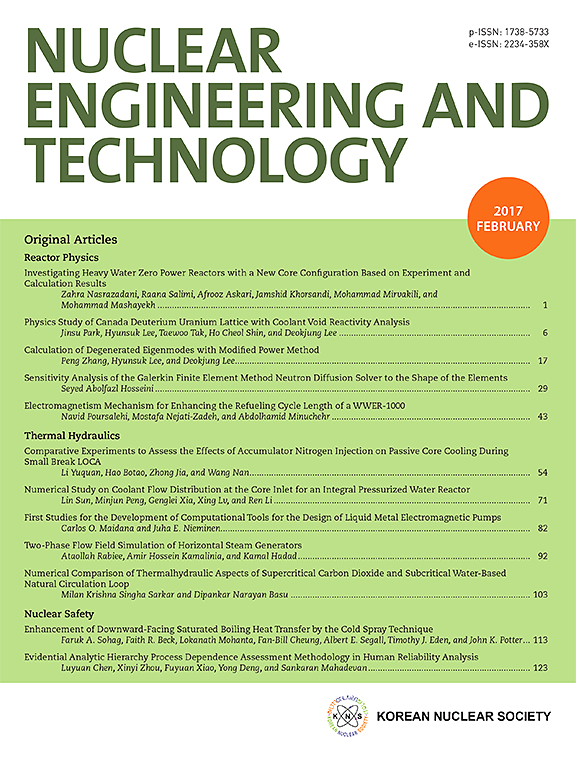Multivariate model predictive control study of large scale PWR nuclear power plant based on the asymptotic method
IF 2.6
3区 工程技术
Q1 NUCLEAR SCIENCE & TECHNOLOGY
引用次数: 0
Abstract
Third-generation PWR nuclear power plants face increased grid peaking tasks, demanding enhanced load following capabilities of the reactor control system. The MPC algorithm, owing to its advantage, more effectively addresses grid peaking challenges. Therefore, a model predictive control algorithm based on the asymptotic method is utilized to research advanced control of PWR models. Initially, the paper conducts identification experiments based on asymptotic identification method and the characteristics of PWR. A reduced-order model is derived from a higher-order model based on identification data and objective function minimization. Model order selection is guided by the asymptotic criterion. The identified model demonstrates good performance in the frequency domain according to the model validation theory of asymptotic method. In time domain validation, the error percentage of the model output is low and the step response exhibits correct direction. Subsequently, a model predictive controller is designed based on the identification model, and simulation analysis is conducted for four working conditions respectively. Under load step conditions, the MPC controller markedly reduced both regulation time and steady-state error compared to the original controller, achieving a complete elimination of steady-state error and over 75 % reduction in regulation time for average coolant temperature control. Concurrently, under conditions of load ramping, the MPC controller achieved a significant reduction of over 99 % in the ITSE as compared to the original controller. However, it should be noted that the output frequency and intensity are higher for MPC controller compared to the original controller.
基于渐近方法的大型压水堆核电站多变量模型预测控制研究
第三代压水堆核电站面临电网调峰任务的增加,对反应堆控制系统的负荷跟随能力提出了更高的要求。MPC算法由于其自身的优势,能够更有效地解决电网峰值问题。因此,采用基于渐近方法的模型预测控制算法对压水堆模型进行超前控制研究。本文首先基于渐近辨识方法,结合压水堆的特点,进行了辨识实验。基于识别数据和目标函数最小化,从高阶模型推导出降阶模型。模型阶次选择以渐近准则为指导。根据渐近方法的模型验证理论,所识别的模型在频域上表现出良好的性能。在时域验证中,模型输出的错误率低,阶跃响应方向正确。随后,基于辨识模型设计了模型预测控制器,并分别对四种工况进行了仿真分析。在负载阶跃条件下,与原始控制器相比,MPC控制器显著减少了调节时间和稳态误差,实现了完全消除稳态误差,并将平均冷却剂温度控制的调节时间减少了75%以上。同时,在负载陡增的条件下,MPC控制器在ITSE中实现了超过99%的显着减少,与原始控制器相比。然而,应该注意的是,与原始控制器相比,MPC控制器的输出频率和强度更高。
本文章由计算机程序翻译,如有差异,请以英文原文为准。
求助全文
约1分钟内获得全文
求助全文
来源期刊

Nuclear Engineering and Technology
工程技术-核科学技术
CiteScore
4.80
自引率
7.40%
发文量
431
审稿时长
3.5 months
期刊介绍:
Nuclear Engineering and Technology (NET), an international journal of the Korean Nuclear Society (KNS), publishes peer-reviewed papers on original research, ideas and developments in all areas of the field of nuclear science and technology. NET bimonthly publishes original articles, reviews, and technical notes. The journal is listed in the Science Citation Index Expanded (SCIE) of Thomson Reuters.
NET covers all fields for peaceful utilization of nuclear energy and radiation as follows:
1) Reactor Physics
2) Thermal Hydraulics
3) Nuclear Safety
4) Nuclear I&C
5) Nuclear Physics, Fusion, and Laser Technology
6) Nuclear Fuel Cycle and Radioactive Waste Management
7) Nuclear Fuel and Reactor Materials
8) Radiation Application
9) Radiation Protection
10) Nuclear Structural Analysis and Plant Management & Maintenance
11) Nuclear Policy, Economics, and Human Resource Development
 求助内容:
求助内容: 应助结果提醒方式:
应助结果提醒方式:


